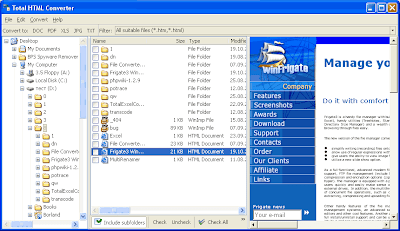Wednesday, May 23, 2007
DViCO's TViX M-5100SH offers 1080p, HDMI, and H.264 decoding
Filed under: HDTV, Home Entertainment
Continue reading DViCO's TViX M-5100SH offers 1080p, HDMI, and H.264 decoding
Posted by
Augustine
at
3:25 PM
![]()
Labels: media encoder
Plinkme.com - Free Exposure, Free Photos for Your Site
Posted by
Augustine
at
3:13 PM
![]()
Labels: photos for blogs
Convert HTML Web pages to JPG Images or PDF Documents
 Total HTML Converter supports different charsets and encoding tables and can fit HTML Width to the chosen PDF-Page-Size.
Total HTML converter costs around ~$40 but you can have this useful HTML conversion tool for free providing you start your downloading engines within the next 24 hours.
Download Total HTML Converter at Give Away of the Day for free. No watermarks.
Total HTML Converter supports different charsets and encoding tables and can fit HTML Width to the chosen PDF-Page-Size.
Total HTML converter costs around ~$40 but you can have this useful HTML conversion tool for free providing you start your downloading engines within the next 24 hours.
Download Total HTML Converter at Give Away of the Day for free. No watermarks.
Posted by
Augustine
at
3:01 PM
![]()
Labels: html converter, jpeg, pdf
MIT's handheld FAR-NDT device sees cracks in structures
Filed under: Transportation
Posted by
Augustine
at
2:21 PM
![]()
Labels: crack detector, MIT
Intel's P35 "Bearlake" chipset gets benchmarked, reviewed
Read | Permalink | Email this | Comments
Posted by
Augustine
at
9:23 AM
![]()
Labels: intel bearlake
Dell XPS 720 H2C gets official
Posted by
Augustine
at
9:22 AM
![]()
Labels: liquid cooling for the masses
Medical records of Colorado residents compromised
On MPR's wavLength blog and American Public Media's Future Tense program, there's a story about how we came across personally identifiable medical records for thousands of residents of Colorado (and some from Illinois) on an FTP server that required no username/password to view the data. Data was sensitive, and some records included SSNs.
Posted by
Augustine
at
8:57 AM
![]()
Labels: identity theft, medical record
Monday, May 21, 2007
Why English is Hard
Big difference between "attendee" and "attendant" -- one attends, the other attends to. :-)
Posted by
Augustine
at
12:00 PM
![]()
Brother's RL-700S prints out RFID cards
Filed under: Peripherals, Wireless
Posted by
Augustine
at
10:23 AM
![]()
Labels: RFID cards
Dell's ultra-thin LCD concept with DisplayPort going retail?
Filed under: Displays
Researchers tout better, brighter LEDs
Filed under: Displays
Read | Permalink | Email this | Comments
Posted by
Augustine
at
10:19 AM
![]()
Labels: LED backlight LCD
AppleTV hacked to run Xgrid
Filed under: Desktops, Home Entertainment
8-core NextDimension PC stretches the definition of portable
Filed under: Desktops, Laptops
Toshiba's NC-MR technology could boost HDD capacity 'tenfold'
Posted by
Augustine
at
10:12 AM
![]()
Labels: toshiba hard drive


